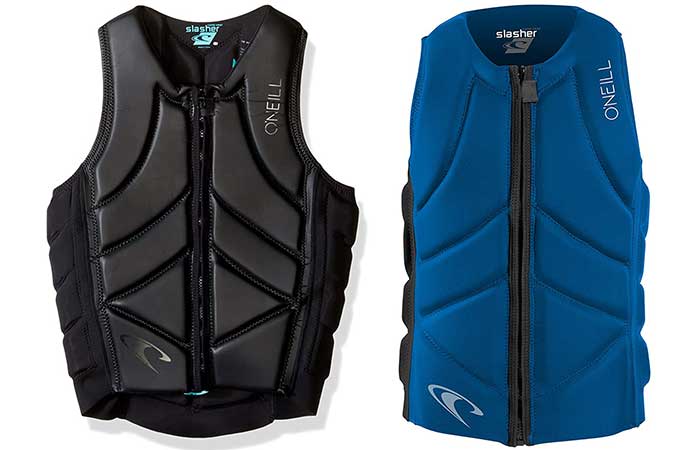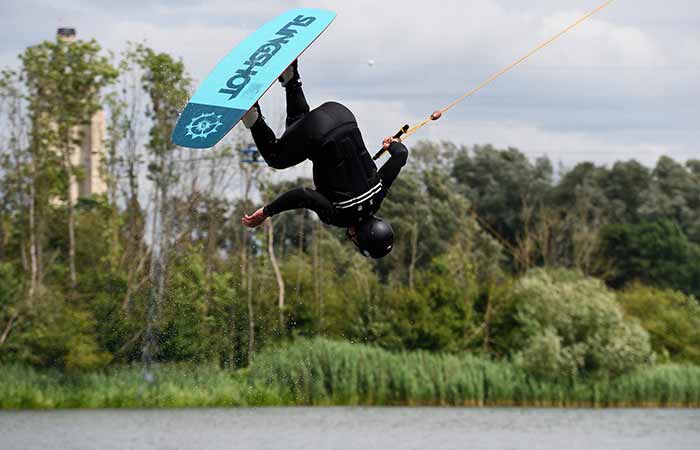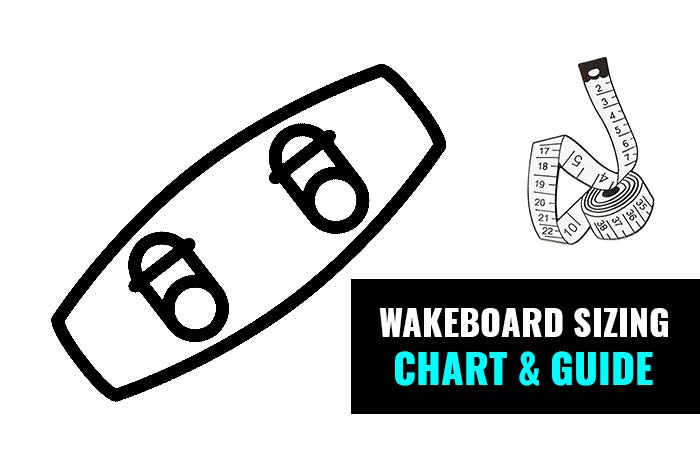How to Get Up on a Wakeboard
If you’re reading this, you likely want to get your feet wet in one of the most thrilling water sports, wakeboarding. But before you can pull off those exciting mid-air stunts that make wakeboarding so alluring, you should be able to get up on your wakeboard.
Getting up on a wakeboard isn’t rocket science. And, your athletic ability, age, and fitness levels aren’t limiting factors. All you need to do is strike the rights pose in water and let the towing boat pull you up.
Find you Stance
Before you embark on wakeboarding, you should first figure out your ideal riding stance; you’re either regular or goofy.
Regular riders intuitively put their left foot forward with their dominant right foot at the back. Goofy wakeboarders lead with their right foot with the dominant left foot at the back. By having your dominant foot at the rear, you’ll be able to balance and turn much more easily.
But how do you figure out your dominant foot? For your one, you can try kicking a ball. Typically, we intuitively kick a ball using our dominant foot; so that’s the foot that should be at the rear of your wakeboard.
You can also try putting on pants. We typically stand on our dominant foot as we slide the other leg into the pants. So the leg you slide first into your pants should at the fore of the wakeboard.
How to Position Your Body
Envision yourself leaning back on a comfortable low chair with your feet decked on the coffee table. Now, what will you do when you want to get up?
You’ll likely take your feet off the coffee table and position them close to the front of your chair. You will then lean forward and move your bum close to the edge of your sit. Then, with your weight centered on your feet, you’ll push yourself upward, to a standing position.
But what if someone is helping your get up? Well, you won’t have to push yourself upwards. Instead, you’ll hold on to their hands and they’ll pull you up quite easily. In the context of wakeboarding, that person helping you get up is your towing boat.
Getting Up Your Board
- Once your towing boat gets in position, use your hands to paddle to a point where you’re facing the boat.
- You should then shift into a ‘getting up’ position. This means you should bend your knees and tuck your ankles close to your bum. Then, you should hold on to the tow rope with your arms straight but relaxed and with your palms facing downward. Your chest you should be up. And, your board should be perpendicular to the surface of the water with your toes peeking out of the water.
- As your boat accelerates and starts tugging, you should create a positive upward angle with your board by shifting a bit of your weight to the heels. Your board will act as a wing; it’ll help you glide to the surface.
- Once you’re on the water surface, maintain your squatting position. Then, get into your riding stance by turning your wakeboard so that it’s perpendicular to the boat; you’ll achieve this by shifting the tow rope to your leading hip (goofy or regular).
- To maintain balance, your movements should be deliberate and slow. As you glide on the water, your knees should remain slightly bent and softened.
- Once the boat has picked pace and you’ve gotten your bearings, you should then rise slowly to a standing position.
Getting Up Variations for Beginners
Other than the regular method discussed above, there are other ways you can get up on your wakeboard, let’s take a look:
Dock Start
The docks start is another easy, ‘getting up’ method that’s suitable for beginners. It’s also ideal in cold conditions. With this method, you need a dock and you should be able to communicate with your driver easily.
There are a few types of dock starts. For one, you can get up on your board by jumping off the dock. Start by standing an inch away from the periphery of the dock while holding the tow rope.
Once the boat starts tugging, jump into the water while leaning back slightly – a little bit more of your weight should be on the heels. Once you’ve gained balance in the water, position your body in your preferred riding posture.
You can also start by sitting on the periphery of the dock with your knees bent while facing the boat. The tow rope should be in your hands and you should lean back as if you’re sitting on a comfortable low couch.
As you’re towed into the water, a little bit more of your weight should be balanced on the heels, and you should hold the tow rope handle close to your hips. Once you’re in the water, you should then shift to your riding stance by shifting the rope to your leading hip.
Deep Water Start
With the deep water method, you should stand on your board with your knees slightly bent. Then, you should hold the tow rope with your palms facing down and your arms straight.
Once the boat starts towing, you should shift your weight to your heels and create an upward angle of about ten degrees. Your board will easily glide to the top. Once you’re on the water, you should then shift to your riding stance.
How to Stay Up
Once you’re up on your board, your next goal is likely gliding on water, turning, and traversing across the wakes. To achieve this, you should continually shift your weight to your toes (front edge) and then back to your heels (back edge). This ‘toeside-heelside’ movement allows you to maneuver and cut in and out.
If you fall or lose grip, stay down and ensure your board is halfway above the water – this will make you visible to the boats around you. Your boat driver will get you the tow rope so that try getting up again.

Common Mistakes that Beginners Make When trying to Get up on a Wakeboard
- One of the most common mistakes that beginners make is standing too quickly. At the beginning when you’re gliding at a low speed, the water is quite soft. So when you stand up too early, you put extra pressure on your board which increases drag. As your board slows, your torso doesn’t, so you end up tumbling frontward.
- Pulling your tow rope while leaning back is also a common counterproductive move. While in this position, you’re basically in a rope pulling contest with the boat with your board pushing against the water; you don’t stand a chance.
- Another common misconception is that being pulled by a boat that’s going at higher speed will give you the thrust needed to get up much more easily. But in actuality, a speeding boat makes it harder for you to get up. Your towing boat’s speed should ideally be below 26 km/h.
Other Getting up Tips
- Bend your knees and maintain strong arms and shoulders so that you’re not pulled forward. You should stand, slowly, only after the boat has picked pace and you’ve gained balance.
- You need a clear way of communicating with your driver. You can use hand signals like thumbs-down/thumbs-up to let them know how you’re fairing and what you need them to do.
- Sometimes all you have to do when you’re having trouble getting up is to switch your feet. For instance, if you had your left foot on the fore, you should shift your right foot to the fore instead.
- As a beginner wakeboarder, you’ll have it easier getting up when using a shorter tow rope. Your rope you ideally should be about 6.1m (20 feet).
- Ensure your bindings are well adjusted. If you tie them loosely, you’ll have a hard time maintaining balance on your board. Conversely, if you tie them too tightly, riding will be a painful affair; your feet will be too constrained and they’ll hurt.
- As a beginner, your back binding should be positioned close to the back edge of your board, on the back fin. This makes it easier for you to control your wakeboard and puts most of your weight on the back fin when your lean back. Leaning back enables you to stay up on your board as it prevents the front edge from tipping into the water.
What Should You do If You can’t Get Up?
Some learners fail to get up on their wakeboards even after numerous attempts. Getting up can be a challenge because it involves taking numerous steps in the right sequence. But what prevents most learners from getting up is that they try to pull themselves up. Getting up on your wakeboard is all about technique, not brute force.
If you’ve tried a few times without success, don’t give up. Rest for a bit and switch into the ‘getting up position’ and let the boat do the heavy lifting. You’ll likely get up on your board in every other attempt after your first success.
Further Reading on Wakebording
- How to Wakeboard: A Basic Beginner Guide +Tips
- How to Jump on a Wakeboard
- Wakeboard Tricks & Names: Easiest to the Hardest
- Wakeboarding vs Wake Surfing
- How to Pick the Right Wakeboard Size-Chart & Guide
- 7 Best Wakeboards + Buy Guide
- Best Wakeboard Life Jackets & Vests for Women, Men & Kids
- Best Wakeboard Bindings & Boots
- 7 Best Wakeboard Towers-What to look for when Buying


![7 Best Wakeboards + Buy Guide [2021]](https://aquaticglee.com/wp-content/uploads/2021/01/best-wakeboards.jpg)




